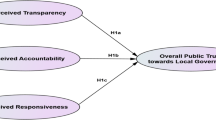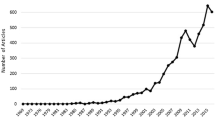Abstract
Constitutional economics may be defined as the study of constraints chosen by cooperative groups. In this paper, the scope of constitutional economics is extended by an examination of the constitutions and rules that govern seven of the eight largest U.S. Christian denominations. This examination of church constitutions reveals constitutional provisions and church rules that protect denominational reputation by preserving doctrinal integrity and constraining the behavior of local churches, clergy, and individual members. By protecting their reputations, religious denominations may increase their appeal to current or prospective members or both.
Similar content being viewed by others
References
Anderson, G.M. (1988) “Mr. Smith and the Preachers: The Economics of Religion in theWealth of Nations.”Journal of Political Economy 96: 1066–1088.
Buchanan, J. (1990) “The Domain of Constitutional Economics.”Constitutional Political Economy 1: 1–18.
The Book of Discipline of the United Methodist Church 1988. Nashville, Tennessee: The United Methodist Publishing House.
Clarkson, K. (1972) “Some Implications of Property Rights in Hospital Management.”Journal of Law and Economics 15: 363–385.
Coriden, J.A., Green, T.J., and Heintschel, D.E. (eds) (1985)The Code of Canon Law: A Text and Commentary. New York: Paulist Press.
Constitution (1988) The Southern Baptist Convention.
Constitutions, Bylaws, and Continuing Resolutions. (1991) The Evangelical Lutheran Church in America.
Constitutions & Canons for the Government of the Protestant Episcopal Church in the United States. (1988) The Episcopal Church.
The Constitution of the Presbyterian Church (U. S. A.) Part II Book of Order. (1988) Louisville, KY: The Office of the General Assembly.
Fama, E.F., and Jensen, M.C. (1983) “Separation of Ownership and Control.”Journal of Law and Economics 26: 301–325.
Handbook of The Lutheran Church-Missouri Synod. (1986) St. Louis, MO: The Lutheran Church-Missouri Synod.
Hansmann, H. (1981) “Nonprofit Enterprise in the Performing Arts.”Bell Journal of Economics 12: 341–361.
Jacquet, C.H. Jr., and Jones, A.M. (eds) (1991)Yearbook of American and Canadian Churches 1991. Nashville: Abingdon Press.
James, E. (1986) “How Nonprofits Grow: A Model.” In: Rose-Ackerman (ed)The Economics of Nonprofit Institutions: Studies in Structure and Policy. Oxford: Oxford University Press.
Klien, B., and Leffler, K. (1981) “The Role of Market Forces in Assuring Contractual Performance.”Journal of Political Economy 89: 614–641.
Lipford, J.W. (1992) “Group Size and the Free-Rider Hypothesis: An Examination of New Evidence.” Unpublished manuscript. Presbyterian College.
Melton, J.G. (1989)The Encyclopedia of American Religions. 3d ed. Detroit: Gale Research Inc.
Newhouse, J. (1970) “Towards a Theory of Nonprofit Institutions: An Economic Model of a Hospital.”American Economic Review 60: 64–73.
Niskanen, W.A. Jr. (1971)Bureaucracy and Representative Government. Chicago: Aldeine Publishing Co.
Pauly, M., and Redish, M. (1973) “The Not-for-Profit Hospital as a Physicians' Cooperative.”American Economic Review 63: 87–99.
Roberts, J.E. (ed) (1992) “Convention Wrap Up.”Baptist Courier 124: 6-7.
Steinberg, R. (1986) “The Revealed Objective Functions of Nonprofit Firms.”Rand Journal of Economics 17: 508–526.
Weinberg, C.B. (1980) “Marketing Mix Decision Rules for Nonprofit Organizations.”Research in Marketing 3: 191–234.
Author information
Authors and Affiliations
Rights and permissions
About this article
Cite this article
Lipford, J. Organizational reputation and constitutional constraints: An application to religious denominations. Constit Polit Econ 3, 343–357 (1992). https://doi.org/10.1007/BF02393140
Issue Date:
DOI: https://doi.org/10.1007/BF02393140




